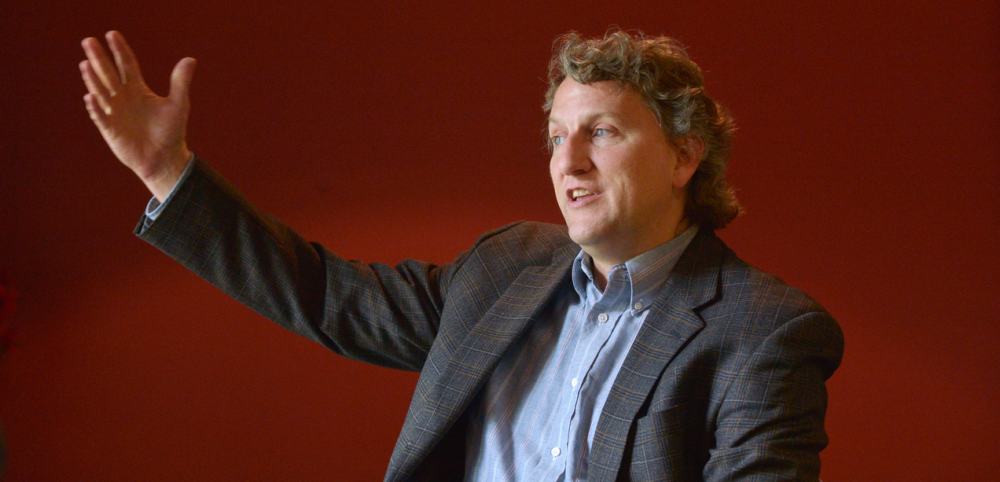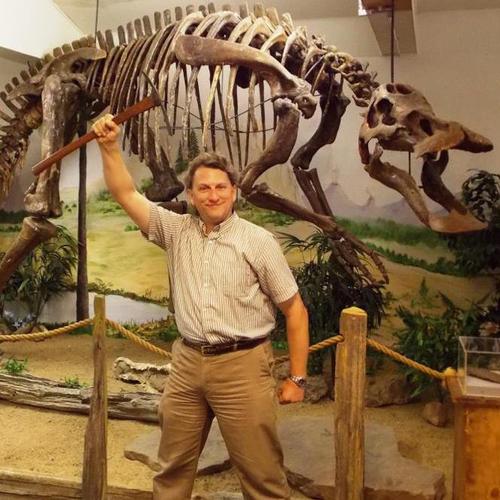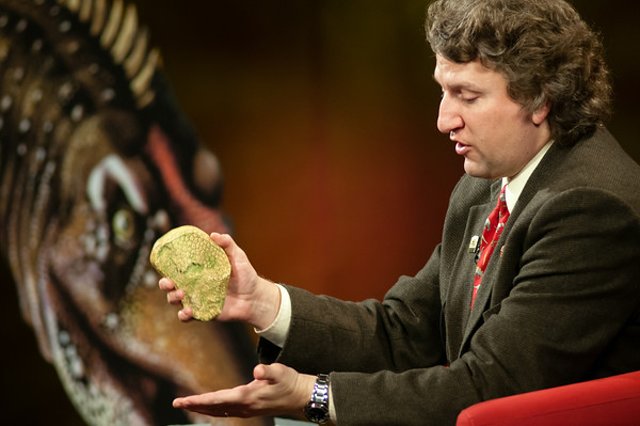Thomas R. Holtz is a very well-known and respected member of the paleontology community. His work with tyrannosaurids and other theropod dinosaurs is unparalleled, as he has made many contributions in his career that have allowed us to better understand and classify these diverse, fascinating creatures.
Holtz is a senior lecturer on vertebrate paleontology in the University of Maryland’s Department of Geology and he’s been a published author many times over. He’s also a tremendous follow on Twitter (especially since he talks about Jurassic Park a lot).
All in all, Holtz is a paleontology superstar, and we got the chance to interview him through email this week. Holtz tackled the entire world of dinosaurs for us, including the terrifying thought of two tyrannosaurids mating:
Robot Butt: You’re essentially a T-Rex expert. What’s the most interesting thing you’ve ever learned about the creature?
Thomas R. Holtz: Wow. Like asking an astronomer what’s the most interesting thing they’ve ever learned about stars…I think the most interesting thing is that we can learn so much about it. There are enough specimens, with enough of them well enough preserved, that we can determine many attributes about them: how they fed, how they moved, how they grew, what their senses were like, even something about what diseases they had. And even a certain amount of information about the proteins in their bones.
That all said, if there were two most interesting things about them it would be their incredible bite force (among the strongest in Earth history that we know of) and their life cycle (under 500 kgs until age 10 or so, than rapid growth to full 6-8 tons by age 18).
RB: Can we call you a T-Rexpert?
TRH: Sure!
RB: You’ve done so much for the dinosaur community – you’re a published author numerous times over, you’ve developed new theories, and you’ve led the charge on classifying tyrannosauroids correctly. What’s it like being a rock star of the paleontology community? What perks does it bring?
TRH: The main perks would be getting invited to give talks around the country, or in other countries. I get to see interesting places and meet interesting people, and share the wonders of dinosaurs with them. (Plus, sometimes when I check in at conferences I don’t have to give my name to the people at registration: that’s kinda cool.)
RB: What, in your opinion, went wrong in Jurassic Park?
TRH: In the story universe? Not having an appropriate staff stationed on the island, including have more than just Muldoon in case an exhibit broke free. And not watching the damn Weather Channel! How does a tropical storm sneak up on someone in modern times!!
The idea of a zoo-like park where the expensive rare large animal-to-handler staff ratio seems to be considerably greater than 1 (or 10, or more!) is pretty ridiculous. People (including the movie makers) want to make it out like it is Man’s Hubris which is responsible for all the problem, but really it was failures of management. In the end they are just big animals, not the Divine Wrath of Nature.
RB: If you were in Dr. Grant’s shoes, would you have still signed off on the park, given the tremendous scientific achievement of bringing dinosaurs back to life? Like Hammond said, even Disney World opened with some hiccups.
TRH: As with my comments above, it really was mostly a management problem. But all those are issues that should have been in place during the early phases of producing the animals and setting up the park, not after they are essentially ready to open it. Properly run, it would have been a good thing.
On the other hand, the Isla Sorna nature preserve idea is inherently cruel to the dinosaurs. The various dinosaur species are not adapted to each other at all – they range across tens of millions of years of time, and many different environments. So you are going to have weird interactions going on. Plus vulnerability of the dinosaurs to modern pathogens which evolved after they died out, and thus for which they have no immunities. Plus the basic ecology of the island: goats and pigs ravage islands the size of Isla Sorna and larger (in places like the Galápagos) while feeding, so what about herds of sauropods, hadrosaurids, and ceratopsids? The island’s vegetation would be stripped in just a few years.
RB: If you had to pick one dinosaur to come back to life, what would it be?
TRH: So long as it is properly contained, Tyrannosaurus rex. But it might be more manageable to start with something like Microraptor or Protoceratops.
RB: When we were kids, the discovery of the Gigantosaurus felt like a really big deal, but its impact on the dinosaur world feels somewhat slighted because of the T-Rex’s on-screen depiction as the greatest force on Earth. Could you just lay down some truth about the differences between those two dinosaurs?
TRH: I got to be sort of the U.S. ambassador for Giganotosaurus when it first was published, as I was interviewed by a lot of the American news media about it. It is a very interesting dinosaur, it is true. The latest (not peer-reviewed, but pretty reasonable) analysis suggest that the largest Giganotosaurus was actually slightly less heavy than the largest known T. rex. The brain of Tyrannosaurus was about twice the size of Giganotosaurus (the byproduct of tyrannosaurs being the descendants of small, agile relatively brainy coelurosaurs). The olfactory bulbs of tyrannosaurus are proportionately larger than those of carcharodontosaurs like Giganotosaurus, meaning that tyrants likely had a better sense of smell. The eyes of tyrannosaurids were larger, and (especially in Tyrannosaurus) more forward-facing, giving tyrants a better potential for good depth perception.
The heavily reinforced jaws, their muscles, and the thick, deeply rooted teeth of Tyrannosaurus were much better adapted for smashing through flesh and bone and tearing off big portions of flesh than the more delicate jaws and slashing steak-knife teeth of Giganotosaurus. And tyrannosaurids had considerably larger hip and leg muscles and longer and more slender legs (with relatively narrow shock-absorbing feet) compared to carcharodontosaurids, so the tyrant dinosaurs were probably swifter movers.
Still, meeting either of them when you are alone and unarmed would really ruin your day.
RB: Let’s say that I accidentally walk through a portal and I am instantly transported back to the late Cretaceous period. What would I see? How could I best prepare for my survival? How long would I realistically last?
TRH: It would depend upon where and in what season you wound up. Paintings and documentaries to the contrary, there would have been times when the landscape wasn’t crawling with every species of dinosaur and other animal that inhabited that region: some may have migrated in for a time, and many would have been clumped together in herds or packs or flocks rather than randomly distributed over the landscape.
If you wound up in Late Cretaceous Montana, the vegetation would be something like a mix of the forests of southern Japan and of northern Australia, in a setting something like the bayous of the Gulf Coast. Until you saw something distinctly un-modern (like a pterosaur or dinosaur) you might not know you are in another time, but might think instead you were transported to some other corner of the world today. Oh, you would see turtles: lots and lots and lots of turtles.
But when you begin to notice a giant Quetzalcoatlus over head, or the herds of ceratopsians and hadrosaurids, and so forth, finding some sort of cover would be good. Depending on your nature skills, you could probably do well for a while (as well as an individual alone might get along in the most isolated parts of the Amazon rainforest or the Serengeti). Raiding nests might be a safe way of getting protein (so long as the parents aren’t nearby: since all living archosaur groups have some parental nest monitoring, we expect pterosaurs and extinct dinosaurs did the same), as well as snaring/spearing small animals, fishing (watch out for crocodiles…), and raiding kills. By the Late Cretaceous there would have been fruit, but you’d have to experiment carefully to find ones that were good for humans.
I would say that making your home in the trees would be the best bet. The giant pterosaurs of the time would be too big to do much perching on trees, and those dinosaurs that could get up into the trees would generally be small enough that you could fight them off. I think it would be unlikely that tyrannosaurs would try to eat too many tree-dwelling animals when there was ground-based food to go after. There would have been climbing mammals, but these too would hopefully not be too much problem.
(Oh, but don’t let the mammals jab you with their hind limbs! It appears that spurs, possibly poisonous, were common to many Mesozoic mammal groups, and that their presence in male platypus today is simply their last remnant.)
RB: Have you ever had the opportunity to name a new species of dinosaur? And if you get to again in the future (or do so for the first time), would you ever consider a name that spites someone, like the BetterThanBobasaurus?
TRH: There is a long delayed project on a small dinosaur that I am helping to name. And I have suggested names to some authors while reviewing their manuscripts, with variable success. But I wouldn’t waste the time naming fossil species out of spite when there are plenty of cool potential names to be used.
RB: If you were to ever discover a really bizarre and unsettling fossil, like a dinosaur body with a human skull somehow, would you make it known to the world or pretend like you never saw it?
TRH: I would have to, but only after we really, really, really, really, really thoroughly check out the fossil, the setting, its discovery, and so on. Ockham’s Razor would be in full force: if it was something that was really contradictory to all established evidence, would it be more likely that it was a hoax (which we know people do) or not? Until we could thoroughly reject the hoax idea, we’d have to consider it a possibility.
RB: We were going to try to ask a really well-researched question about your work with dinosaurs to humorously contrast the rest of these silly questions, but we weren’t able to understand even the abstract of your research paper “The Phylogenetic Position of the Tyrannosauridae: Implications for Theropod Systematics” well enough to come up with anything. What’s it like being so smart?
TRH: It can be lonely at times…<pines>
Seriously, though, part of the issue that people have to get through in order to do science is that technical terminology is required. But that is true about any field: just ask someone who’s into audio equipment, or baseball statistics, or porcelain antiques, or whatever. The more you get into a particular field, the more you realize you need a specialized terminology to be exact about material.
Which is why when I write kid’s books I don’t really try to “dumb” it down; I just try to simplify the terminology. And not use so much math and statistics…
RB: It’s a bright sunny day in the rolling hills of rural Maryland. You’re on a beautiful hike with that special someone, having a wonderful time and making memories that you’ll treasure forever. As you jump over a gorgeous blue babbling brook, you notice your shoelace is untied. After helping your date cross the stream, you bend down to tie your shoe. As you stand back up, you see a T-Rex 100 yards downwind. It hasn’t noticed you yet. How do you save yourself and your date? How well can it smell you? Should you run or stay still? Will you need to sacrifice your date to save yourself?
TRH: The size of the olfactory lobes of Tyrannosaurus point to an excellent sense of smell. So assuming it recognizes human smell as food, I need to get out of there. Standing still just makes it easy for them (part of Jurassic Park’s long-lasting memetics is the “if you don’t move, it can’t see you” nonsense.) I can’t sacrifice my wife to save me, so I’d better make lots of noise to get its attention and distract it. (Or find a third party and get it to go after them!)
Probably the best approach would be to run and climb as quickly as possible to a setting where it would be at a disadvantage: in between closely-spaced trees, or up a scree slope where it couldn’t run. Or into a pasture full of cows and sheep and hope it goes after them.
If the stream leads quickly enough to a decent-sized river, try to make it to that and jump in. Tyrannosaurs almost certainly could swim, but they probably wouldn’t have gone out of their way to do it while hunting.
RB: The thought of two tyrannosaurids mating is very terrifying. Do you ever give much thought to it?
TRH: Stop looking at my search history…
Sure, dinosaur mating in general is an interesting topic, but mating of theropods like tyrannosaurs seems pretty straightforward. The mechanics of spike-backed Kentrosaurus seems a lot more problematic!
What I do wonder more, but unfortunately something that is unlikely ever to be known, is what the courtship rituals of extinct dinosaurs were like. Those of modern dinosaurs (aka birds) and of their more distant cousins the crocodilians and the lizards can be quite elaborate and showy, and very different even among closely related species. So the same would have likely been true of Mesozoic dinosaurs. But dances and songs and displays don’t fossilize, so we are unlikely to ever really know the mating call of Tyrannosaurus or the courtship dance of Gallimimus.



